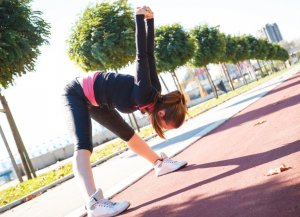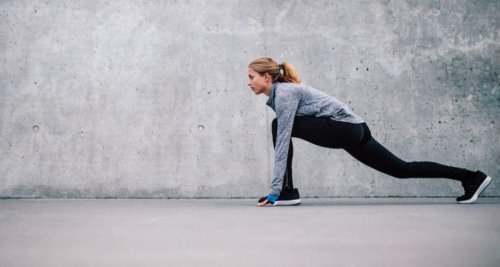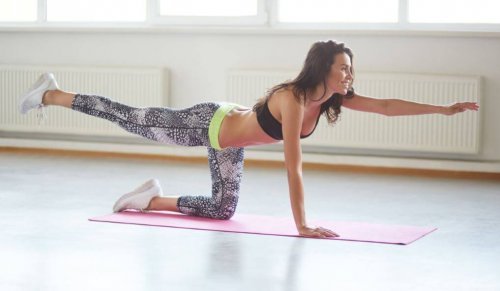Post-Exercise Stretching Routine

Lots of people make the mistake of not stretching after exercising. Not only is this detrimental to the muscles, but it can also cause injuries and other long-term problems that we will later regret. Let’s review the importance of stretching and look at a routine that we can do after exercising.
Why is a stretching routine important?
Although many people don’t believe it or choose not to believe it, stretching is as important, or more so than exercising and resting. It should be a part of every sports routine and these are the reasons why:
- Stretching reduces muscle tension. Muscles are like motorized machines that fill up with energy when tensed, and unload when they are relaxed. When they are full of energy, they are more likely to suffer greater injuries. Stretching will make them relax and release the accumulated energy.
- Increases your range of movement. When tense muscles are stretched with the intent to relax them, a force is created that compels them to go beyond what they could, by just relaxing. This allows for a wider range of movement; hence, training will be easier in the next session.
- Improves circulation.
- Prevents muscle fatigue. Stretching helps the body return to its natural state, thus, avoiding fatigue and extreme added weariness.
Post-exercise stretching routine
Not everyone is aware of the stretches that are appropriate and correct. In order to save you from this situation, we have created a stretching routine that will bring you all of the aforementioned benefits.
Legs, biceps, and femoral stretches
Bend one leg in and towards you, while the other is stretched outward. Reach the foot of the stretched-out leg with the hand that corresponds to the same side of that leg. Hold this position for 20 or 30 seconds, and repeat with the other leg and arm.

Hip flexion
This type of stretch is as simple as taking a stride. Take a mat and put both knees on it. Place one of the legs forward as if you were going to get up, and lift the other leg, to send it backwards, making sure that the knee doesn’t touch the ground, and you’re in a lunge position.
While holding this stance, push your hips forward. This way you will feel some tension in the front leg, which indicates that you are stretching the muscle. Hold that position between 20 and 30 seconds and repeat on the other side.

Abdominal stretches
The abdominal area is one of the most important areas to stretch. This is because it’s your core that maintains your balance. To stretch properly, lie on a mat, face down and put your hands straight on the floor. Raise your abdomen and pelvis, while supporting yourself with your arms, holding the plank position for 30 seconds.
Glutes
Standing, bend one leg and carry the other over the thigh of the bent leg, while holding the tip of your foot to maintain balance. Stay in a crouching position, the lower you go, the more you stretch the gluteus.
Back and chest
Put your hands behind your back and hold them together. Stretch your arms as far as you can, while keeping your back and legs straight and your buttocks slightly outward. Hold this position for about 30 seconds.

Thighs
In a squat position, stretch out one of your legs, and hold the extension for as long as you can. Do the same with the other leg.
Arm stretching
If you have performed many exercises that involve working with your arms, put them behind your back, and hold your hands together. Then, bend over, and lift your hands behind your back while stretching to the fullest. Hold this position for about 30 seconds.
These are just some of the exercises that we advise are included in a stretching routine. Put them into practice and you will see how much your resistance and flexibility improves.
Lots of people make the mistake of not stretching after exercising. Not only is this detrimental to the muscles, but it can also cause injuries and other long-term problems that we will later regret. Let’s review the importance of stretching and look at a routine that we can do after exercising.
Why is a stretching routine important?
Although many people don’t believe it or choose not to believe it, stretching is as important, or more so than exercising and resting. It should be a part of every sports routine and these are the reasons why:
- Stretching reduces muscle tension. Muscles are like motorized machines that fill up with energy when tensed, and unload when they are relaxed. When they are full of energy, they are more likely to suffer greater injuries. Stretching will make them relax and release the accumulated energy.
- Increases your range of movement. When tense muscles are stretched with the intent to relax them, a force is created that compels them to go beyond what they could, by just relaxing. This allows for a wider range of movement; hence, training will be easier in the next session.
- Improves circulation.
- Prevents muscle fatigue. Stretching helps the body return to its natural state, thus, avoiding fatigue and extreme added weariness.
Post-exercise stretching routine
Not everyone is aware of the stretches that are appropriate and correct. In order to save you from this situation, we have created a stretching routine that will bring you all of the aforementioned benefits.
Legs, biceps, and femoral stretches
Bend one leg in and towards you, while the other is stretched outward. Reach the foot of the stretched-out leg with the hand that corresponds to the same side of that leg. Hold this position for 20 or 30 seconds, and repeat with the other leg and arm.

Hip flexion
This type of stretch is as simple as taking a stride. Take a mat and put both knees on it. Place one of the legs forward as if you were going to get up, and lift the other leg, to send it backwards, making sure that the knee doesn’t touch the ground, and you’re in a lunge position.
While holding this stance, push your hips forward. This way you will feel some tension in the front leg, which indicates that you are stretching the muscle. Hold that position between 20 and 30 seconds and repeat on the other side.

Abdominal stretches
The abdominal area is one of the most important areas to stretch. This is because it’s your core that maintains your balance. To stretch properly, lie on a mat, face down and put your hands straight on the floor. Raise your abdomen and pelvis, while supporting yourself with your arms, holding the plank position for 30 seconds.
Glutes
Standing, bend one leg and carry the other over the thigh of the bent leg, while holding the tip of your foot to maintain balance. Stay in a crouching position, the lower you go, the more you stretch the gluteus.
Back and chest
Put your hands behind your back and hold them together. Stretch your arms as far as you can, while keeping your back and legs straight and your buttocks slightly outward. Hold this position for about 30 seconds.

Thighs
In a squat position, stretch out one of your legs, and hold the extension for as long as you can. Do the same with the other leg.
Arm stretching
If you have performed many exercises that involve working with your arms, put them behind your back, and hold your hands together. Then, bend over, and lift your hands behind your back while stretching to the fullest. Hold this position for about 30 seconds.
These are just some of the exercises that we advise are included in a stretching routine. Put them into practice and you will see how much your resistance and flexibility improves.
This text is provided for informational purposes only and does not replace consultation with a professional. If in doubt, consult your specialist.








